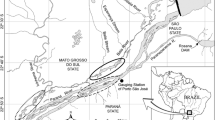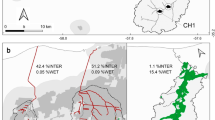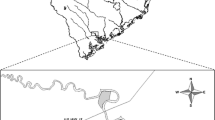Abstract
Lake Tana is one of East Africa’s largest freshwater bodies, yet many of its fishes are migratory and utilize in-flowing tributaries as critical spawning habitat. However, factors such as expanding water resources developments and sand mining along these rivers and streams may disrupt this ecosystem function. We monitored juvenile and adult fish abundance and water quality across five lake tributaries from August 2014 to April 2015 to examine how irrigation schemes and water quality affect assemblage and population structure. Adult assemblages were dominated by Labeobarbus cyprinids and varied between tributaries, albeit without separation by irrigation development or sand mining. Overall, adult abundances of the dominant migratory Labeobarbus species were four-fold higher below the Shini River irrigation weir than upstream. Contrastingly, juvenile abundances were often significantly higher above these structures. Juvenile abundances decreased on average by 46% along the first 1000 m of two irrigation canals, suggesting poor habitat suitability or high mortalities from water withdrawals. Water quality varied more between rivers than sampling times, but without any separation of tributaries by irrigation or sand mining. Conductivity and turbidity-related parameters had the highest correlation with adult assemblage structure and individual species abundances. These findings indicate that Lake Tana tributaries must be managed on a case by case basis, with more focus given to mechanisms allowing fish to bypass irrigation developments and the direct assessment of fish populations between sand mining and other sites.






Similar content being viewed by others
Data availability
All data are available from the corresponding author upon request.
References
Abate M, Nyssen J, Moges MM, Enku T, Zimale FA, Tilahun SA, Adgo E, Steenhuis TS (2017) Long-term landscape changes in the Lake Tana Basin as evidenced by delta development and floodplain aggradation in Ethiopia. Land Degrad Dev 28:1820–1830. https://doi.org/10.1002/ldr.2648
Anteneh W, Getahun A, Dejen E (2011) Assessment of downstream dispersal of juveniles of the migratory riverine spawning Labeobarbus species of Lake Tana (Ethiopia). Proc Ethiop Fish Aquat Sci Assoc 2:198–206
Anteneh W, Getahun A, Dejen E (2013) Spawning migrations of Lake Tana Labeobarbus spp. (Teleostei: Cyprinidae) in the Ribb River, Ethiopia. Afr J Aquat Sci 38(Suppl):61–68. https://doi.org/10.2989/16085914.2013.776942
Anteneh W, Getahun A, Dejen E, Sibbing FA, Nagelkerke LA, de Graaf M, Wudneh T, Vijverberg J, Palstra AP (2012) Spawning migrations of the endemic Labeobarbus (Cyprinidae, Teleostei) species of Lake Tana, Ethiopia: status and threats. J Fish Biol 81:750–765. https://doi.org/10.1111/j.1095-8649.2012.03362.x
Baumgartner LJ, Boys C (2012) Reducing the perversion of diversion: Applying world-standard fish screening practices to the Murray-Darling Basin. Ecol Manag Restor 13:135–143. https://doi.org/10.1111/j.1442-8903.2012.00655.x
Bayram A, Önsoy H (2015) Sand and gravel mining impact on the surface water quality: a case study from the city of Tirebolu (Giresun Province, NE Turkey). Environ Earth Sci 73:1997–2011. https://doi.org/10.1007/s12665-014-3549-2
Behrmann-Godel J, Eckmann R (2003) A preliminary telemetry study of the migration of silver European eel (Anguilla anguilla L.) in the River Mosel, Germany. Ecol Freshw Fish 12:196–202. https://doi.org/10.1034/j.1600-0633.2003.00015.x
Bell M, DeLacy A (1972) A compendium on the survival of fish passing through spillways and conduits. Fisheries Engineering Research Program, US Army Engineers Division, North Pacific Corps of Engineers, Portland
Bunn SJ, Arthington AH (2002) Basic principles and ecological consequences of altered flow regimes for aquatic biodiversity. Environ Manag 30:492–507. https://doi.org/10.1007/s00267-002-2737-0
Chen J, Chang H (2019) Dynamics of wet-season turbidity in relation to precipitation, discharge, and land cover in three urbanizing watersheds, Oregon. River Res Appl 35:892–904. https://doi.org/10.1002/rra.3487
Clarke KR, Gorley RN (2015) Primer v7: User Manual / Tutorial. Primer-E, Plymouth
Daniels RA (2001) Untested assumptions: the role of canals in the dispersal of sea lamprey, alewife, and other fishes in the eastern United States. Environ Biol Fish 60:309–329. https://doi.org/10.1023/A:1011032907484
de Graaf M, Machiels MAM, Wudneh T, Sibbing FA (2004) Declining stocks of Lake Tana’s endemic Barbus species flock (Pisces; Cyprinidae): natural variation or human impact? Biol Conserv 116:277–287. https://doi.org/10.1016/S0006-3207(03)00198-8
de Graaf M, Nentwich D, Osse JWM, Sibbing FA (2005) Lacustrine spawning: is this a new reproductive strategy among ‘large’ African cyprinid fishes? J Fish Biol 66:1214–1236. https://doi.org/10.1111/j.0022-1112.2005.00671.x
de Graaf M, van Zwieten PAM, Machiels MAM, Lemma E, Wudneh T, Dejen E, Sibbing FA (2006) Vulnerability to a small-scale commercial fishery of Lake Tana’s (Ethiopia) endemic Labeobarbus compared with African catfish and Nile tilapia: an example of recruitment-overfishing? Fish Res 82:304–318. https://doi.org/10.1016/j.fishres.2006.05.011
Dejen E, Anteneh W, Vijverberg J (2017) The decline of the Lake Tana (Ethiopia) fisheries: causes and possible solutions. Land Degrad Dev 28:1842–1851. https://doi.org/10.1002/ldr.2730
Duker L, Borre L (2001) Biodiversity conservation of the World’s lakes: a preliminary framework for identifying priorities. LakeNet Report Series, Number 2. Monitor International, Annapolis, Maryland
Dudgeon D, Arthington AH, Gessner MO, Kawabata Z-I, Knowler DI, Lévêque C, Naiman RJ, Prieur-Richard A-H, Soto D, Stiassny MLJ, Sullivan CA (2006) Freshwater biodiversity: importance, threats, status and conservation challenges. Biol Rev 81:163–182. https://doi.org/10.1017/S1464793105006950
Dzikowski M, Jobard S (2012) Mixing law versus discharge and electrical conductivity: relationships: application to an alpine proglacial stream. Hydrol Process 26:2724–2732. https://doi.org/10.1002/hyp.8366
Gebler RJ (1998) Examples of near-natural fish passes in Germany: drop structure conversions, fish ramps and bypass channels. In: Jungwirth M, Schmutz S, Weiss S (eds) Fish migration and fish bypasses. Blackwell Science, London, pp 403–419
Gebremedhin S, Getahun A, Anteneh W, Gedif B, Gashu B, Tefera B, Berhanie Z, Alemaw D (2017) Effect of large weirs on abundance and diversity of migratory Labeobarbus species in tributaries of Lake Tana, Ethiopia. Afr J Aquat Sci 42:367–373. https://doi.org/10.2989/16085914.2017.1411774
Gebremedhin S, Mingist M, Getahun A, Anteneh W (2012) Spawning migration of Labeobarbus spp. (Pisces: Cyprinidae) of Lake Tana to Arno-Garno River, Lake Tana sub-basin, Ethiopia. SINET: Ethiopian J Sci 35:95–106
Getahun A, Dejen E (2012) Fishes of Lake Tana: A guidebook. Addis Ababa University Press, Addis Ababa
Haro A, Odeh M, Noreika J, Castro-Santos T (1998) Effect of water acceleration on downstream migratory behaviour and passage of Atlantic salmon smolts and juvenile American shad at surface bypasses. T Am Fish Soc 129:351–380
Heppell CM, Binley A, Trimmer M, Darch T, Jones A, Malone E, Collins AL, Johnes PJ, Freer JE, Lloyd CEM (2017) Hydrological controls on DOC: nitrate resource stoichiometry in a lowland, agricultural catchment, southern UK. Hydrol Earth Syst Sci 21:4785–4802. https://doi.org/10.5194/hess-21-4785-2017
Humphries P, Cook RA, Richardson AJ, Serafini LG (2006) Creating a disturbance: manipulating slackwaters in a lowland river. River Res Appl 22:525–542. https://doi.org/10.1002/rra.920
Humphries P, Richardson A, Wilson G, Ellison TL (2013) River regulation and recruitment in a protracted-spawning fish. Ecol Appl 23:208–225. https://doi.org/10.1890/11-2255.1
Jackson DC, Marmulla G (2001) The influence of dams on river fisheries. In: Marmulla G (ed) Dams, fish and fisheries. Opportunities, challenges and conflict resolution. FAO Fisheries Technical Paper No. 419. FAO, Rome, pp 1–44
Jamu DM, Chimphamba JB, Brummett RE (2003) Land use and cover changes in the Likangala catchment of the Lake Chilwa basin, Malawi: implications for managing a tropical wetland. Afr J Aquat Sci 28:123–135. https://doi.org/10.2989/16085910309503777
Junk WJ, Bayley PB, Sparks RE (1989) The flood-pulse concept in river-floodplain systems. Can J Fish Aquat Sci Spec Publ 106:110–127
Karlberg L, Hoff H, Amsalu T, Andersson K, Binnington T, Flores-López F, de Bruin A, Gebrehiwot SG, Gedif B, Zur Heide F, Johnson O, Osbeck M, Young C (2015) Tackling complexity: understanding the food-energy-environment nexus in Ethiopia’s Lake Tana sub-basin. Water Altern 8:710–734
King AJ, O’Connor JP (2007) Native fish entrapment in irrigation systems: A step towards understanding the significance of the problem. Ecol Manag Restor 8:32–37. https://doi.org/10.1111/j.1442-8903.2007.00329.x
King JM, Cambray JA, Impson DN (1998) Linked effects of dam-released floods and water temperature on spawning of the Clanwilliam yellowfish Barbus capensis. Hydrobiologia 384:245–265. https://doi.org/10.1023/A:1003481524320
Kingsford RT (2000) Ecological impacts of dams, water diversions and river management on floodplain wetlands in Australia. Austral Ecol 25:109–127. https://doi.org/10.1046/j.1442-9993.2000.01036.x
Kjelland MF, Woodley CM, Swannack TM, Smith DL (2015) A review of the potential effects of suspended sediment on fishes: potential dredging-related physiological, behavioural and transgenerational implications. Environ Syst Decis 35:334–350. https://doi.org/10.1007/s10669-015-9557-2
Koehnken L, Rintoul MS, Goichot M, Tickner D, Loftus A-C, Acreman MC (2020) Impacts of riverine sand mining on freshwater ecosystems: A review of the scientific evidence and guidance for future research. River Res Appl 36:362–370. https://doi.org/10.1002/rra.3586
Lorenzen K, Smith L, Nguyen Khoa S, Burton M, Garaway C (2007) Guidance Manual: management of impacts of irrigation development on fisheries. The WorldFish Center, Penang, and International Water Management Institute, Colombo
Marten K, Segers HH (2009) Endemism in inland waters. In: Likens GE (ed) Encyclopedia of Inland Waters, Volume 1. Elsevier, Oxford, pp. 423–430
Mequanent D, Mingist M (2019) Potential impact and mitigation measures of pump irrigation projects on Lake Tana and its environs, Ethiopia. Heliyon 5:e03052. https://doi.org/10.1016/j.heliyon.2019.e03052
Mingist M, Gebremedhin S (2016) Could sand mining be a major threat for the declining endemic Labeobarbus species of Lake Tana, Ethiopia? Singapore J Trop Geo 37:195–208. https://doi.org/10.1111/sjtg.12150
MoWR (Ministry of Water Resources) (2010) Environmental and social impact assessment of about 20,000 ha irrigation and drainage schemes at Megech pump (Seraba), Ribb and Anger dam environmental and social impact assessment of the Ribb irrigation and drainage project, Volume 2/2: Annexes (Final version). Ethiopian Ministry of Water Resources, Addis Ababa
Nagelkerke LAJ, Sibbing FA (2000) The large barbs (Barbus spp., Cyprinidae, Teleostei) of Lake Tana (Ethiopia), with a description of a new species, Barbus osseensis. Neth J Zool 50:179–214. https://doi.org/10.1163/156854200X00072
Nagelkerke LAJ, Sibbing FA, van den Boogaart JGM, Lammens EHRR, Osse JWM (1994) The barbs (Barbus spp.) of Lake Tana: a forgotten species flock? Environ Biol Fish 39:1–22. https://doi.org/10.1007/bf00004751
Nessler TP, Muth RT, Wasowicz AF (1988) Evidence for baseline flow spikes as spawning cues for Colorado squawfish in the Yampa River, Colorado. Am Fish Soc Symp 5:68–79
O’Connor JP, O’Mahony DJ, O’Mahony JM, Glenane TJ (2006) Some impacts of low and medium head weirs on downstream fish movement in the Murray–Darling Basin in southeastern Australia. Ecol Freshw Fish 15:419–427. https://doi.org/10.1111/j.1600-0633.2006.00162.x419
Palstra AJ, de Graaf M, Sibbing FA (2004) Riverine spawning and reproductive segregation in a lacustrine cyprinid species flock, facilitated by homing? Anim Biol 54:393–415
Poff NL, Allan JD, Bain MB, Karr JR, Prestergaard KL, Richter BD, Sparks RE, Stromberg JC (1997) The natural flow regime. BioScience 47:769–784. https://doi.org/10.2307/1313099
Roberts JJ, Rahel FJ (2008) Irrigation canals as sink habitat for trout and other fishes in a Wyoming drainage. T Am Fish Soc 137:951–961. https://doi.org/10.1577/T07-058.1
Rolls RJ, Growns IO, Khan TA, Wilson GG, Ellison TL, Prior A, Waring CC (2013) Fish recruitment in rivers with modified discharge depends on the interacting effects of flow and thermal regimes. Freshw Biol 58:1804–1819. https://doi.org/10.1111/fwb.12169
Steenhuis TS, Tilahun SA, Tessema ZK, Tebedu TY, Moges M, Zimale FA, Worqlu AW, Alemu ML, Ayana EK, Mohamed YA (2014) Soil erosion and discharge in the Blue Nile Basin: Trends and challenges. In: Assefa MM, Abtew W, Shimelis GS (eds) Nile River Basin: Ecohydrological Challenges, Climate Change and Hydropolitics. Springer, Switzerland, pp 133–147. https://doi.org/10.1007/978-3-319-02720-3_8
Sutherland AB (2007) Effects of increased suspended sediment on the reproductive success of an upland crevice spawning minnow. T Am Fish Soc 136:416–422. https://doi.org/10.1577/T06-046.1
Sutherland AB, Meyer JL, Gardiner EP (2002) Effects of land cover on sediment regime and fish assemblage structure in four southern Appalachian streams. Freshw Biol 47:1791–1805. https://doi.org/10.1046/j.1365-2427.2002.00927.x
Tesfaye G, Wolff M (2014) The state of inland fisheries in Ethiopia: a synopsis with updated estimates of potential yield. Ecohydrol Hydrobiol 14:200–209. https://doi.org/10.1016/ecohyd.2014.05.001
Teshome G, Getahun A, Mingist M, Anteneh W (2015) Spawning migration of Labeobarbus species to some tributary rivers of Lake Tana, Ethiopia. Ethiopian J Sci Technol 8:37–50. https://doi.org/10.4314/ejst.v8i1.4
Thorstad EB, Økland F, Aarestrup K, Heggberget TG (2007) Factors affecting the within-river spawning migration of Atlantic salmon, with emphasis on human impacts. Rev Fish Biol Fisher 18:345–371. https://doi.org/10.1007/s11160-007-9076-4
Underwood AJ (1994) Beyond BACI: Sampling designs that might reliably detect environmental disturbance. Ecol Appl 4:3–15. https://doi.org/10.2307/1942110
Vijverberg J, Sibbing FA, Dejen E (2009) Lake Tana: Source of the Blue Nile. In: Dumont HJ (ed) The Nile: Origin, environments, limnology and human use. Monographiae Biologicae, vol 89. Springer Science + Business Media B.V, Dordrecht, pp 163–192. https://doi.org/10.1007/978-1-4020-9726-3_9
Westerberger H, Rönnbäck P, Frimansson H (1996) Effects of suspended sediments on cod eggs and larvae and on the behaviour of adult herring and cod. ICES CM Report 1996/E:26. International Council for Exploration of the Sea, Thünen-Institut, Rostock
Worku M (2017) Lake Tana as Biosphere Reserve: Review. J Tourism Hospit 6:310. https://doi.org/10.4172/2167-0269.1000310
Zimale FA, Moges MM, Alemu ML, Ayana EK, Demissie SS, Tilahun SA, Steenhuis TS (2018) Budgeting suspended sediment fluxes in tropical monsoonal watersheds with limited data: the Lake Tana basin. J Hydrol Hydromech 66:65–78. https://doi.org/10.1515/johh-2017-0039
Acknowledgements
The authors thank The Rufford Foundation (Grant No. 10137-2) and the Blue Nile Water Institute at Bahir Dar University for their financial support of this study. The Bahir Dar Fish and Other Aquatic Life Research Center loaned us sampling gears, and we especially thank B. Hailu for assistance in the field and with fish species identification. Constructive feedback from F. Taddese helped improve the manuscript prior to submission.
Code availability
Not applicable.
Funding
Financial support was provided by The Rufford Foundation (Grant No. 10137–2 to AG) and the Blue Nile Water Institute at Bahir Dar University.
Author information
Authors and Affiliations
Contributions
GT, AG, MM and WA conceived and designed the study, which was undertaken with funding obtained by AG. GT performed the fieldwork, and GW analysed the data. GT and GW wrote the manuscript.
Corresponding author
Ethics declarations
Ethics approval
All sampling was undertaken in accordance with animal ethics approval from Bahir Dar University’s Animal Ethics and Experimentation Committee.
Consent to participate
Not applicable.
Consent for publication
All authors read and approved of the manuscript prior to its submission.
Competing interests
This manuscript is original work carried out by the authors. This work has not been published previously and is not under consideration for publication elsewhere. The authors declare that they have no known competing financial interests, personal relationships or conflicts of interest that could have appeared to influence the subject matter or materials reported in this paper.
Additional information
Publisher’s note
Springer Nature remains neutral with regard to jurisdictional claims in published maps and institutional affiliations.
Rights and permissions
About this article
Cite this article
Teshome, G., Getahun, A., Mingist, M. et al. Influence of irrigation infrastructures and water quality on fish assemblages in Lake Tana tributaries, north-west Ethiopia. Environ Biol Fish 104, 653–673 (2021). https://doi.org/10.1007/s10641-021-01101-y
Received:
Accepted:
Published:
Issue Date:
DOI: https://doi.org/10.1007/s10641-021-01101-y




